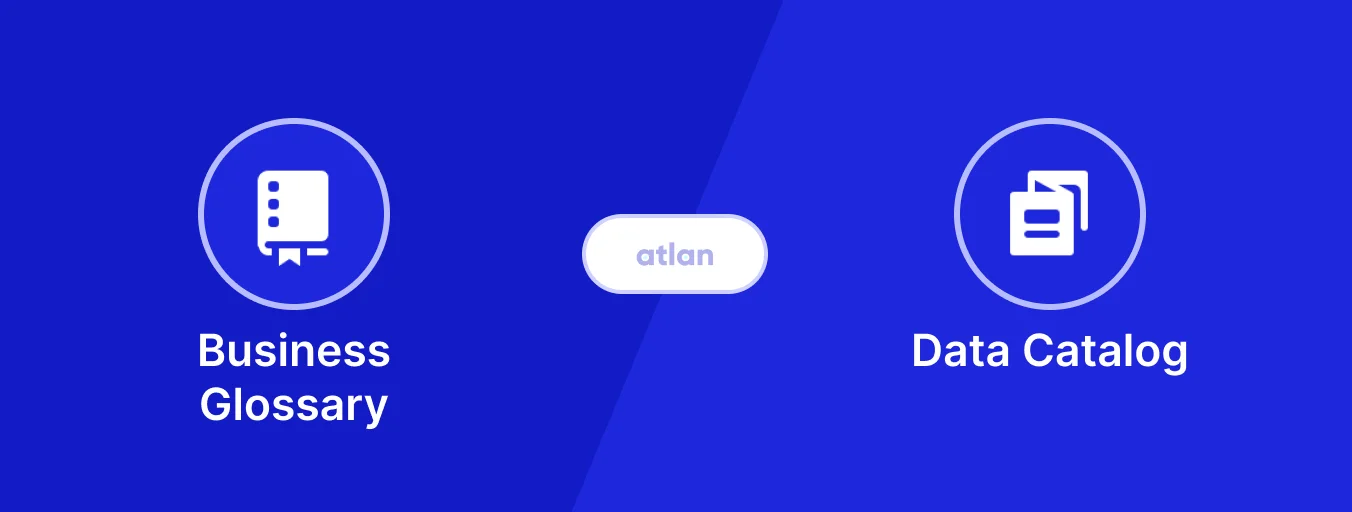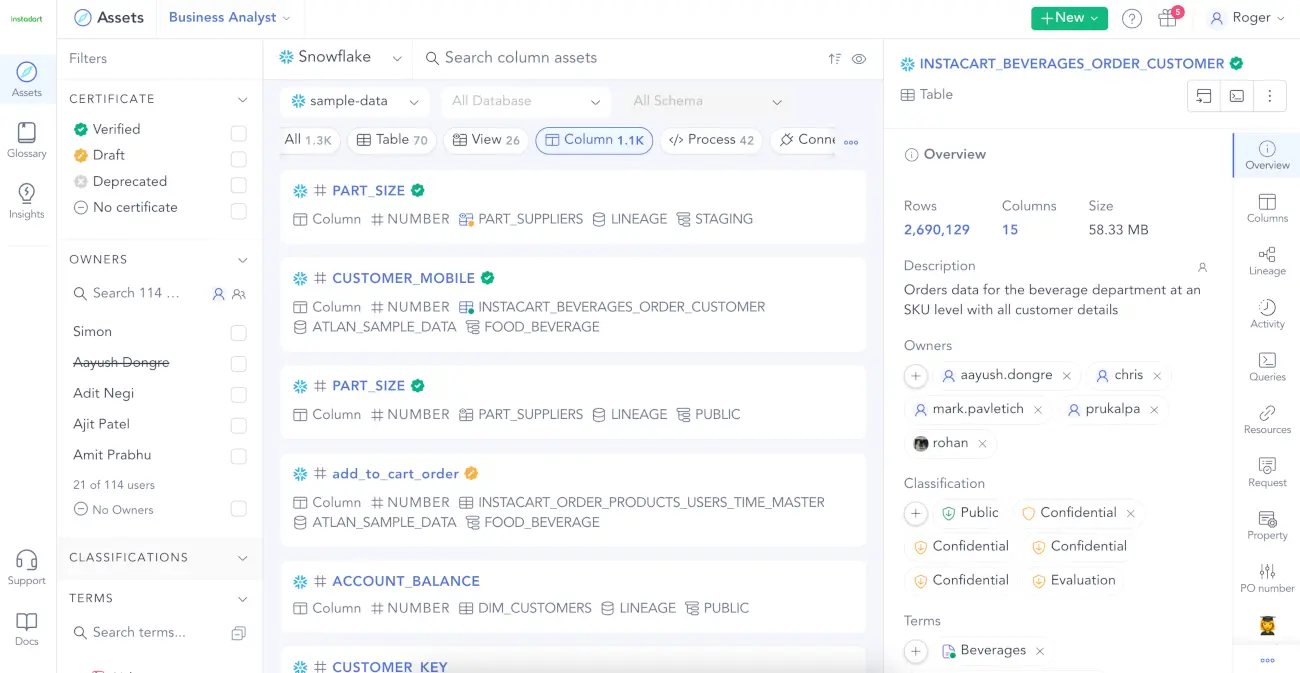Business Glossary vs. Data Catalog: Definition, Differences & Examples

Share this article
Business glossary vs. data catalog: First things first #
Think of it this way — for a business glossary and a data catalog to serve their core purpose, it’s best they co-exist. So if you are looking to choose between the data catalog and business glossary, we’d suggest you hold before you read through this, and understand how they both work in tandem to empower data users with finding, understanding, trusting, and using data.
The main difference between a data catalog and a business glossary is that a business glossary helps you define a common language or way to talk about the data in your organization. A data catalog on the other hand helps you navigate through the entire data ecosystem in your organization.
Business glossary vs. data catalog: Comparison table #
Here’s a quick comparison table between the business glossary and data catalog to help you out.
| Business Glossary | Data Catalog | |
|---|---|---|
| Key features | A business glossary explains the meaning of individual terms. | A data catalog is a detailed inventory of all data assets in an organization. Think of it as an “Index” of all your data. |
| Top benefits | It ensures that everyone speaks the same language across an organization, avoiding miscommunication or chaos. | It ensures that everyone (with the right credentials) can search, discover, understand, and use the data they need instantaneously. This improves the credibility and value of data, minimizes data risks, and guarantees regulatory compliance. |
| Key differences | It standardizes the data-related vocabulary used in an organization with definitions. | It goes beyond a business glossary and provides all the context you need — metadata, data classification, discussions, data quality charts, associated data assets, and lineage. Also, it enables and regulates access at granular levels. |
| Relationship | It’s a prerequisite for good governance and helps make data catalogs more effective. | A business glossary is just one of the many components of data catalogs. |
Modern data catalogs come equipped with a business glossary as a component to ensure that once you find a data asset of interest, you can also gather enough business context around it.
Modern data problems require modern solutions - Try Atlan, the data catalog of choice for forward-looking data teams! 👉 Book your demo today
In the next few sections, we go back to the fundamentals of a business glossary and a data catalog — and go through some use cases that’ll help us understand how they’re leveraged by data teams.
Table of Contents #
- Business glossary vs. data catalog: First things first
- Business glossary vs. data catalog: Comparison table
- What is a business glossary?
- What is a data catalog?
- How do data catalogs leverage the context in a business glossary?
- Think business glossary + data catalog instead of business glossary vs. data catalog.
- Related comparisons
- Data catalog vs. business glossary: Related reads
[Download ebook] → A Guide to Building a Business Case for a Data Catalog
What is a business glossary? #
A business glossary is a centralized repository of all key business terms used in the data-to-day operations of an organization. A business glossary standardizes an organization’s parlance so everyone speaks and understands the same common language.
A business glossary is especially handy in large companies with several lines of business, departments, and a wide variety of data. Each team could end up using different terms or interpreting the same terminologies differently.
Ways to organize information in a business glossary #
To get started you can organize your business glossary in three levels of hierarchy:
- Term: A term is the fundamental unit of a business glossary. This can be a metric definition, a metric formula, or even a business taxonomy.
- Category: Terms are grouped in categories mimicking business usage for better context and organization
- Glossary: Categories are grouped into glossaries. You can think of a business glossary comprised of multiple glossaries belonging to separate teams, business domains, or data sources.
Example of a business glossary #
Here’s an example of how a business glossary gets rid of chaos around data definitions.
The U.S. Government has created a business glossary of typical health insurance terms. The glossary removes confusion between similar-sounding terms, such as Plan Year and Policy Year. While both terms refer to the period of benefits coverage, a Plan Year is for group insurance, whereas a Policy Year is for individuals.
Here are some other examples of public business glossaries so you get the hang of it:
- This data glossary maintained by the Institutional Analytics and Strategic Effectiveness at Minnesota State University
- This consumer glossary by the NAIC
To explore a business glossary in-depth, check out our comprehensive guide on business glossaries.
Business glossaries as we’ve understood by now come with a trove of context around certain terms that you may see as integral to understanding your data assets. But how do you really action this context while working with data? That’s where a data catalog comes into the picture.
What is a data catalog? #
A data catalog helps data professionals discover, understand, and consume data better.
Here’s how Gartner puts it:
A data catalog creates and maintains an inventory of data assets through the discovery, description and organization of distributed datasets. The data catalog provides context to enable data stewards, data/business analysts, data engineers, data scientists and other line of business (LOB) data consumers to find and understand relevant datasets for the purpose of extracting business value.
With a data catalog, you can organize, index, and regulate access to all data assets — with the context (metadata, classifications, and definitions) — for technical and business users alike.

How does a data catalog system look like: An example - Source: Atlan
How do data catalogs leverage the context in a business glossary? #
- Easy access to context: The best data catalog tools surface business glossary context in every asset, every time you search
- Searchable business terms: Modern data catalog tools also let you search data assets via terms of interest
- Crowdsourcing context: Data catalogs also enable you to crowdsource context on data in a business glossary — in a way that fosters trust within your team
- Getting rid of tribal knowledge: Anyone with access to data can add their own context to data in the business glossary via data catalogs. The best-of-breed tools allow easy governance of that — akin to making changes to shared documents on Google docs that need to be accepted by owners
There are many more ways in which a modern data catalog tool can activate business glossaries for a powerful experience of data discovery, understanding, and usage.
Data Catalog 3.0: The Modern Data Stack, Active Metadata and DataOps
Download free ebook
In the real world: Think business glossary + data catalog instead of business glossary vs. data catalog. #
So, a business glossary is part of a data catalog. Data catalogs help you find data assets, collaborate, and share data. With a glossary, they also help you understand key data management terms and stop asking questions like, “what does this data asset mean?” or “what does Y in this report stand for?”
So, how do you get started? Well, it’s simple. Deploy a data catalog tool for your team that’ll help you create and maintain a business glossary — context from which can be surfaced with your data assets when being searched for.
Looking for a list of tools to get started? Check out this list of enterprise data catalog tools listed in Forrester Wave™ Enterprise Data Catalogs For DataOps, Q2 2022 --> Download from here
Related comparisons #
- Data Catalog vs. Data Dictionary: Definitions, Differences, Benefits & Why Do You Need Them?
- Business Glossary vs. Data Catalog: Definitions, Differences, Benefits & Examples.
- Data Inventory vs. Data Catalog: Definitions, Differences, and Examples
- Data Catalog vs. Data Warehouse — Understanding Two Foundational Components of The Modern Data Platform
- Data catalog vs. Data Lineage: Use cases, Evolution of Available Solutions & More
Just in case you are evaluating a data catalog, business glossary, and metadata management for your team do take Atlan for a spin.
Atlan is a modern data catalog built on the premise of embedded collaboration that is key in today’s modern workplace, borrowing principles from GitHub, Figma, Slack, Notion, Superhuman, and other modern tools that are commonplace today.
Data catalog vs. business glossary: Related reads #
- Data Catalog vs. Data Dictionary: Definitions, Differences, Benefits & Why Do You Need Them?
- Data Inventory vs. Data Catalog: Definitions, Differences, and Examples
- What Is a Data Catalog? & Do You Need One?
- Data Dictionary: Examples, Components, Benefits, How To Create One, and Available Tools
- Best Alation Alternative: 5 Reasons Why Customers Choose Atlan
- Explore the Top 6 Benefits of a Data Dictionary
- Data Dictionary vs. Business Glossary: Definitions, Examples & Why Do They Matter?
- Modern Data Catalog: 5 Essential Features and Tool Evaluation Guide
Share this article









